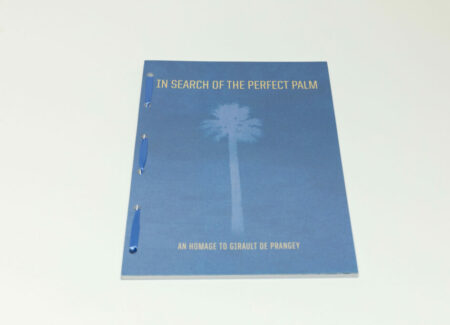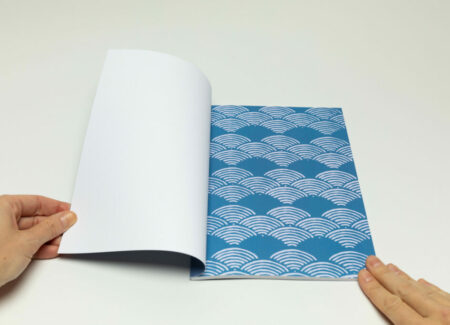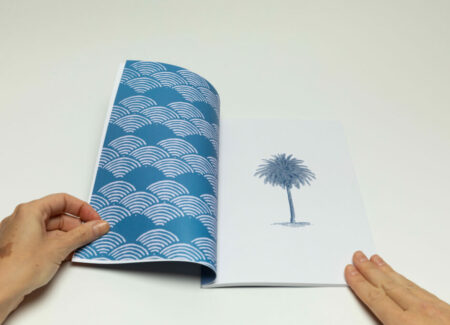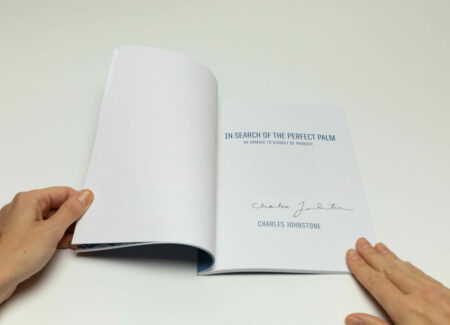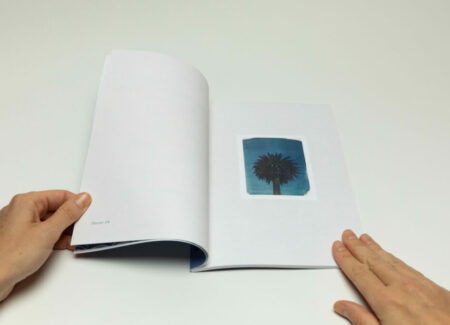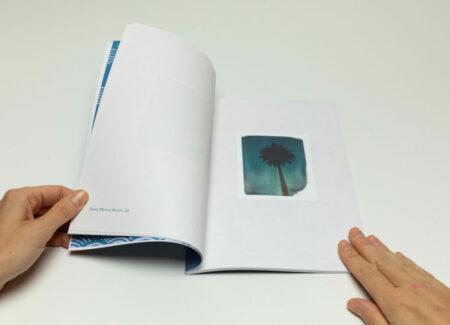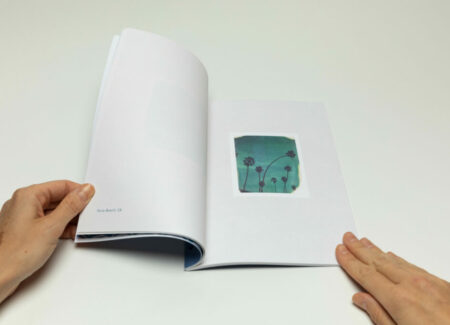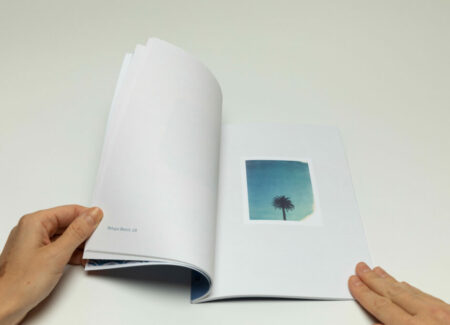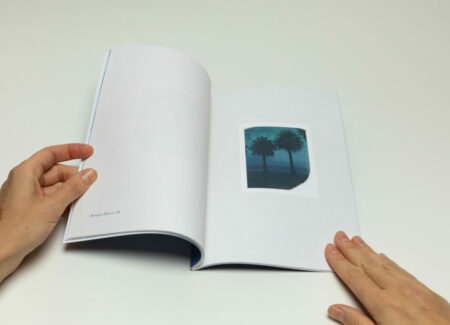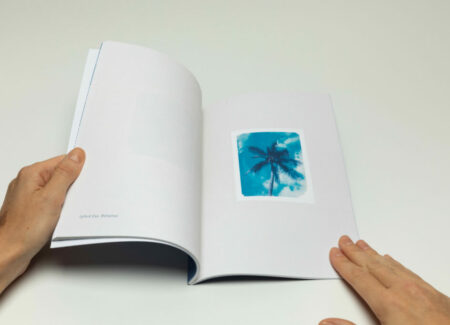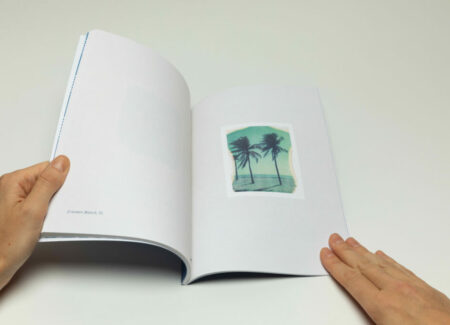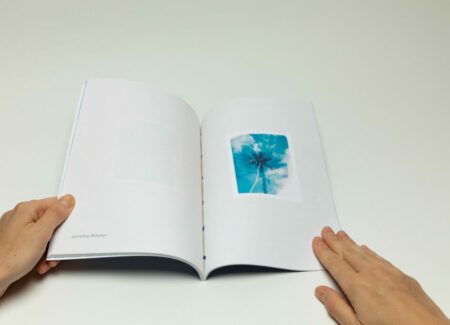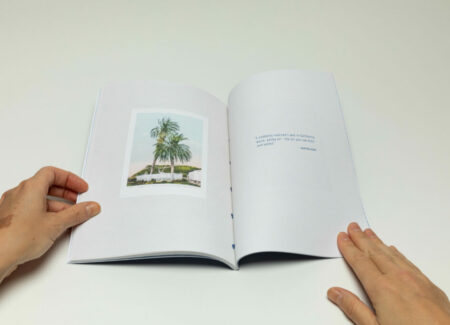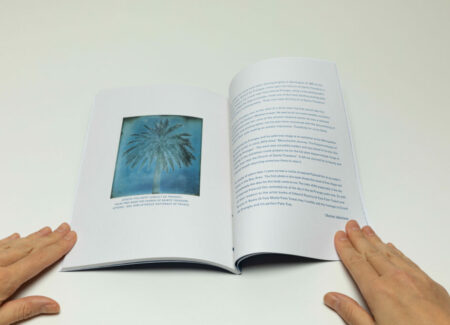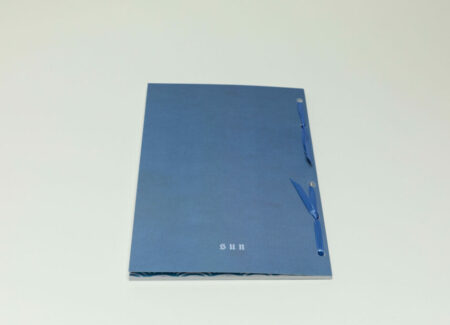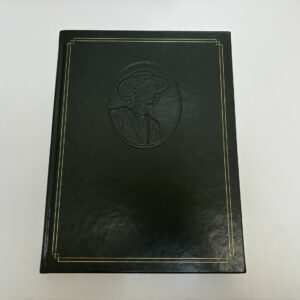JTF (just the facts): Published in 2023 by SUN Editions (no book link, publisher site here). Softcover, 26 pages, with 20 color photographs. Includes an essay by the artist. Design by Bill Sullivan. In an edition of 120 copies. (Cover and spread shots below.)
Comments/Context: The humble palm tree, a relatively banal object, is not a particularly common source of artistic inspiration, yet a number of photographers have been fascinated by it. In the early 1840s, the French photographer Joseph-Philibert Girault de Prangey began an epic three year journey across Europe and into the Middle East, returning to France with over a thousand photographic plates, including the first surviving daguerreotypes of the region. He also made several daguerreotype studies of palm trees, the most famous being “Palm Tree near the Church of Saints Theodore, Athens”, which was included in the Met exhibition “Monumental Journey: The Daguerreotypes of Girault de Prangey” (reviewed here). It is an upward look at the palm crown exploding like a firework. In 1971, Ed Ruscha took up the subject, self-publishing his artist book titled A few palm trees, with fourteen black and white photographs of palms against white backgrounds captioned with their locations. And more recently, the Belgian photographer Bruno V. Roels has added his dense grids of palm tree silhouettes to the intermittent conversation.
The work of these artists, and Girault de Prangey’s in particular, inspired Charles Johnstone to offer his own take on the palm, and the result is his new artist book titled In Search of the Perfect Palm: An Homage to Girault de Prangey. Johnstone, a prolific bookmaker, has published close to twenty photobooks over the past fifteen years. Most of them run in small editions and are carefully crafted, often incorporating hand made elements (like stub binding, boxes, etc).
Last year Johnstone, a court tennis player, together with his long-time collaborator Bill Sullivan, published a two-book set titled Court 1520 2020 exploring “the histories of the games of lawn tennis, court tennis, racquets, trinquete and squash over the past 500 years.” His other most recent series of three photobooks featured Polaroids of actresses he admires, Setsuko Hara, Monica Vitti, and Moira Shearer, each photographed from their films playing on TV (some of which were reviewed here).
Johnstone’s earlier books obsessively documented basketball courts, empty pools, handball courts, Brooklyn fences, and NY storefront churches, and with In Search of the Perfect Palm, Johnstone returns to his experimentation with typologies. All of the photographs were shot on expired Polaroid film stock that he found at his sister’s home in the Bay Area. When the film is expired, the chemical coatings start changing (and eventually become unusable), resulting in unpredictable outcomes, such as distortions, strange color casts, uneven exposure, wiped out edges, streaks, and other imperfections. Johnstone finds this unpredictability particularly exciting, incorporating these chance elements into his artistic vision.
In Search of the Perfect Palm is a small intimate book, and it immediately stands out as a carefully crafted object. It is a softcover book with a vertical orientation, beautifully handbound using Japanese stab binding, the blue ribbon adding a nice touch to its physicality. It has a bluish cover and a faded silhouette of a tall palm appears in the center, breaking the title into two parts. It opens with abstract endpapers, resembling blue sea waves, setting the mood for the visual narrative that follows. The book has a simple layout, with the Polaroids reproduced full size, one per page, placed on the right side of the spread with a generous amount of white space around them. Simple captions indicating the location of each photograph are placed at the bottom of the left page. This elegant design serves its main purpose, which is to present each single subject photographic study with a minimum of distraction.
All of the elements of the book complement each other well, creating a delicately interwoven narrative. It opens with an oft-quoted line from the poem “Place” by the American poet W. S. Merwin, “on the last day of the world, I want to plant a palm tree”. In his later years, Merwin was equally known for his work as a conservationist. In the 1970s, he made Hawaii his home, and over the years, he planted more than 2,700 palm trees on his lands, representing nearly 500 different species. It is now one of the largest palm collections in the world, permanently protected and open to the public. In his own exploration of the palm, Johnstone quietly honors Merwin’s contributions.
All of the photographs in this photobook were made in the past three years, in locations around California, Florida, and the Bahamas. The first Polaroid was shot in Tiburon, CA, the palm evoking Girault de Prangey’s daguerreotype that inspired the project. Seen from the bottom up, it shows its bushy majestic leaves, and the color of the sky shifts to a darker hue due to the chemical reaction. In another image, half a dozen tall skinny palms fill the frame, one of them airily leaning to the side, adding tension to the composition.
As we move through the book, another Polaroid captures two palms on Crandon Beach in Florida, their leaves seeming to rustle by a gust of wind, and the edges of the photograph look burned, evoking another layer of movement. Another happy coincidence is a double exposure shot, where long skinny palm lies on top of a straight one, with their leaves intermingled creating a curious effect, and the distorted colors of the expired film add yet another element of mystery.
Near the end of the book, a spread pairs a postcard depicting two palm trees, believed to be the first palm tree planted in California in 1769. The quote on the right is from Jack Kerouac, “I suddenly realized I was in California, warm, palmy air – the air you can kiss – and palms.” It is followed by a reproduction of Girault de Prangey’s famous daguerreotype of the palm tree, placed next to the text by the artist closing the book.
Seen together, In Search of the Perfect Palm is a self-sufficient and unpretentious project, and that unassuming clarity makes it memorable. Between the elegant design with generous white space and the easy-going dream-like photographs, it gracefully transcends the joy found in the pure act of taking a photograph. The physicality of the book, its paper stock, color, grain, and even the blue ribbon all add to a sensuously tactile experience. It’s a great example of transforming a modest series into an enjoyable and visually engaging photobook.
Collector’s POV: Charles Johnstone is represented by Joseph Bellows Gallery in La Jolla (here). His work has not yet found its way to the secondary markets, so gallery retail remains the best option for those collectors interested in following up.
